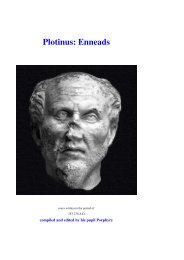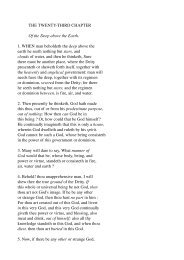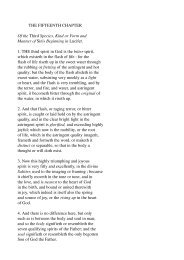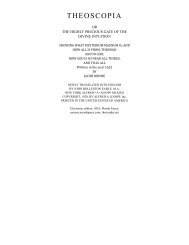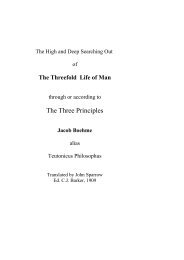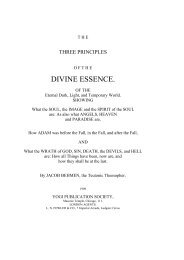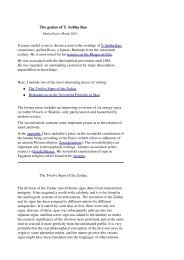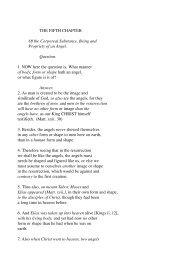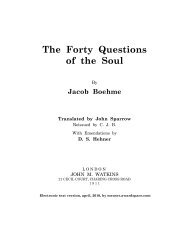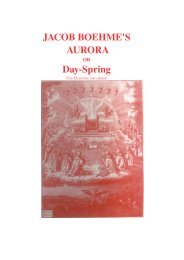Gerald Massey's Lectures - Society in evolution - Awardspace
Gerald Massey's Lectures - Society in evolution - Awardspace
Gerald Massey's Lectures - Society in evolution - Awardspace
Create successful ePaper yourself
Turn your PDF publications into a flip-book with our unique Google optimized e-Paper software.
The third Persian creation is that of earth, which is the dry land of the Hebrew--"and the<br />
Elohim called the dry land Earth."<br />
The fourth Persian creation, or rather creature, is that of plants. This is not a separate<br />
creation <strong>in</strong> the Hebrew version; it is thrown <strong>in</strong>to the third creation, that of earth.<br />
Nevertheless, the third must have <strong>in</strong>cluded the plants because it <strong>in</strong>cludes every herb<br />
yield<strong>in</strong>g seed and every tree that bears edible fruit. And yet <strong>in</strong> chapter 2, verse 5, when<br />
the creations are all completed, and the Elohim had f<strong>in</strong>ished the work which they had<br />
made, we are told that "no plant of the field was yet <strong>in</strong> the earth, and no herb of the field<br />
had yet sprung up." Which proves how mixed and muddled, as well as un-orig<strong>in</strong>al, is the<br />
Mosaic version. In the fourth Hebrew creation the heavenly bodies become the timekeepers<br />
for signs and seasons. This is not one of the six Persian creations, which six are<br />
followed by the "formation of the lum<strong>in</strong>aries." Of these it is said "Ahura-Mazda produced<br />
illum<strong>in</strong>ation between the sky and the earth, the constellation-stars and those not of the<br />
constellations, then the moon; and afterwards the sun." The fifth Persian creation is that<br />
of the animals. This creation is limited to the w<strong>in</strong>ged fowl, sea animals, and fishes, <strong>in</strong> the<br />
Hebrew account, which is considerably mixed.<br />
Mr. Gladstone asks: "Is there the smallest <strong>in</strong>consistency <strong>in</strong> a statement which places the<br />
emergence of our land, and its separation from the sea, and the commencement of<br />
vegetable life, before the f<strong>in</strong>al and full concentration of light upon the sun, and its<br />
reflection on the moon and planets? and as there would be light diffused before there was<br />
light concentrated, why may not that diffused light have been sufficient for the purposes<br />
of vegetation?" Certa<strong>in</strong>ly, as there was light enough to make day before there was any<br />
sun or moon, there ought to, and should, have been. In my reply I am not concerned to<br />
reconcile the literal render<strong>in</strong>g of the Hebrew Genesis with scientific fact, but I shall have<br />
to po<strong>in</strong>t out on behalf of the mythical orig<strong>in</strong>al that accord<strong>in</strong>g to the present <strong>in</strong>terpretation<br />
the heaven and earth could and did exist before the stars, or the moon and the sun! There<br />
was no time kept on earth or <strong>in</strong> heaven until night and day were divided and marked by<br />
the alternation of light and darkness, or by the Tw<strong>in</strong> Star of Even<strong>in</strong>g and Dawn, therefore<br />
the heavenly bodies were not made use of, ergo they did not exist <strong>in</strong> any requisite sense<br />
of the Mythos.<br />
Lastly, man is the product of the sixth creation <strong>in</strong> both render<strong>in</strong>gs. If taken literally, man<br />
of the sixth Persian creation appears on the scene before the stars or moon or sun, which<br />
follow the six creations, not as mere light-givers to the earth, but as time-keepers for man.<br />
And that alone will expla<strong>in</strong> why the stars are said to be <strong>in</strong> existence before the moon; and<br />
the moon before the sun! In the Persian writ<strong>in</strong>gs the <strong>in</strong>variable order is that of stars,<br />
moon, and sun! In describ<strong>in</strong>g the mythical mount Alborz, the mount Meru of the Persian<br />
system of the Heavens, it is said that it grew for 200 years up to the star-station; for 200<br />
more years up to the moon-station; for 200 more years up to the sun-station; for 200 more<br />
years up to the endless light! That is a mode of build<strong>in</strong>g up the heavens <strong>in</strong> accordance<br />
with the order of the Celestial timekeepers, and of the Kronian creations. Time was first<br />
told by the stars, morn<strong>in</strong>g and even<strong>in</strong>g, and by the seven which turned round once <strong>in</strong> the<br />
circle of a year; next by means of the moon and its monthly renewal; next by means of<br />
the sun; solar time be<strong>in</strong>g last because the most difficult to make out.<br />
In a papyrus at Tur<strong>in</strong> it is said of Taht, the god of lunar time, <strong>in</strong> Egypt, "He hath made all<br />
that the world conta<strong>in</strong>s, and hath given it light when all was darkness, and there was as<br />
yet no sun!" This was figurative, and applies solely to the moon, by which time was kept<br />
earlier than it could be def<strong>in</strong>ed by the sun. It is well known that the lunar year and the<br />
lunar zodiac, or pathway of the moon, were earlier than the solar zodiac of 12 signs,<br />
which is too late for the mythical Beg<strong>in</strong>n<strong>in</strong>gs.<br />
In the Babylonian account of creation the moon is produced before the sun. As George<br />
Smith po<strong>in</strong>ts out, this is <strong>in</strong> reverse order to that of the Hebrew Genesis. Evidently, he<br />
says, the Babylonians considered the moon the pr<strong>in</strong>cipal body, while the book of Genesis



